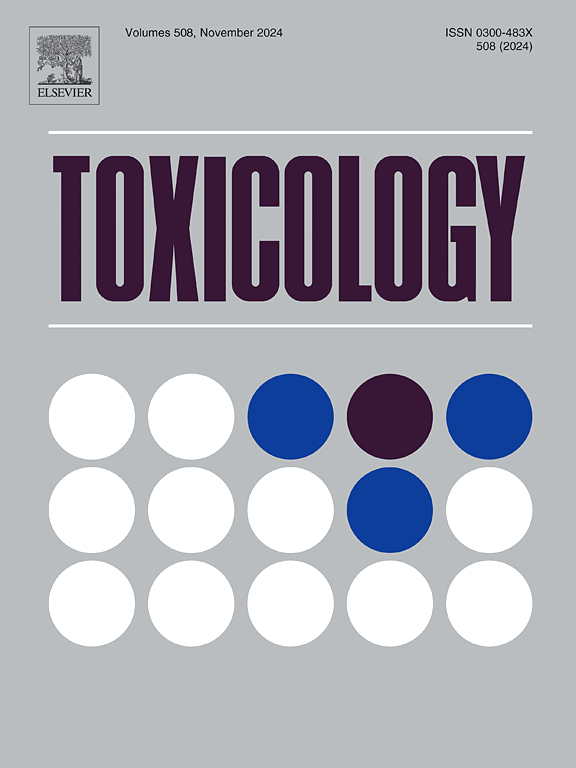Exposure to organophosphate flame retardants and phthalates alters neuronal activity and network development
IF 4.6
3区 医学
Q1 PHARMACOLOGY & PHARMACY
引用次数: 0
Abstract
Exposure to organophosphate flame retardants (OPFRs) and phthalates is associated with neurodevelopmental deficits, impaired neuronal proliferation and differentiation, altered neurotransmitter levels, and impaired learning and memory. Here, we assessed the effects of acute and chronic exposure to the OPFR triphenyl phosphate (TPhP) and several phthalates on neuronal activity and network development in male and female rat primary cortical cultures grown on micro-electrode arrays. Acute exposure to TPhP, diethyl phthalate (DEP), dibutyl phthalate (DBP), and benzyl butyl phthalate (BBzP) inhibited neuronal activity, while chronic exposure to TPhP and DEP induced a hyperexcitation. Chronic exposure to DBP, BBzP, bis(2-ethylhexyl) phthalate (DEHP), and its metabolite mono-2-ethylhexyl phthalate (MEHP) inhibited neuronal network development. Exposure to BBzP and DEHP affected neuronal function at human-relevant concentrations as low as 1 µM. Acute and chronic exposure to the metabolites of DEP, DBP, and BBzP had only limited effects. Although the underlying mechanisms remain to be elucidated, analysis of endocrine mechanisms, including retinoic acid, retinoic X, liver X, and prostaglandin E2 receptor, suggested that the effects of OPFR and phthalates were not endocrine-mediated. Further research is needed to elucidate the mechanisms underlying the different responses to acute and chronic exposure. Taken together, these results add to the evidence that TPhP and various phthalates illicit neurotoxic effects, some at low concentrations. These novel results should be considered in the risk assessment of these chemicals.
暴露于有机磷阻燃剂和邻苯二甲酸盐会改变神经活动和网络发育
接触有机磷阻燃剂(OPFRs)和邻苯二甲酸盐与神经发育缺陷、神经元增殖和分化受损、神经递质水平改变以及学习和记忆受损有关。在这里,我们评估了急性和慢性暴露于OPFR磷酸三苯酯(TPhP)和几种邻苯二甲酸盐对在微电极阵列上生长的雄性和雌性大鼠原代皮层培养物的神经元活动和网络发育的影响。急性暴露于TPhP、邻苯二甲酸二乙酯(DEP)、邻苯二甲酸二丁酯(DBP)和邻苯二甲酸苄丁酯(BBzP)可抑制神经元活动,而慢性暴露于TPhP和DEP可诱导神经过度兴奋。长期暴露于DBP、BBzP、邻苯二甲酸双(2-乙基己基)酯(DEHP)及其代谢物邻苯二甲酸单(2-乙基己基)酯(MEHP)可抑制神经网络发育。暴露于BBzP和DEHP时,与人类相关的浓度低至1 µM,会影响神经元功能。急性和慢性暴露于DEP, DBP和BBzP的代谢物只有有限的影响。虽然潜在的机制仍有待阐明,但对内分泌机制的分析,包括视黄酸、视黄酸X、肝X和前列腺素E2受体,表明OPFR和邻苯二甲酸盐的作用不是内分泌介导的。需要进一步的研究来阐明急性和慢性暴露下不同反应的机制。总之,这些结果进一步证明,TPhP和各种邻苯二甲酸盐非法神经毒性作用,一些低浓度。在对这些化学品进行风险评估时应考虑这些新结果。
本文章由计算机程序翻译,如有差异,请以英文原文为准。
求助全文
约1分钟内获得全文
求助全文
来源期刊

Toxicology
医学-毒理学
CiteScore
7.80
自引率
4.40%
发文量
222
审稿时长
23 days
期刊介绍:
Toxicology is an international, peer-reviewed journal that publishes only the highest quality original scientific research and critical reviews describing hypothesis-based investigations into mechanisms of toxicity associated with exposures to xenobiotic chemicals, particularly as it relates to human health. In this respect "mechanisms" is defined on both the macro (e.g. physiological, biological, kinetic, species, sex, etc.) and molecular (genomic, transcriptomic, metabolic, etc.) scale. Emphasis is placed on findings that identify novel hazards and that can be extrapolated to exposures and mechanisms that are relevant to estimating human risk. Toxicology also publishes brief communications, personal commentaries and opinion articles, as well as concise expert reviews on contemporary topics. All research and review articles published in Toxicology are subject to rigorous peer review. Authors are asked to contact the Editor-in-Chief prior to submitting review articles or commentaries for consideration for publication in Toxicology.
 求助内容:
求助内容: 应助结果提醒方式:
应助结果提醒方式:


